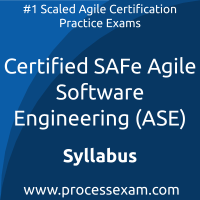 To achieve the professional designation of SAFe Agile Software Engineering from the SAFe, candidates must clear the ASE Exam with the minimum cut-off score. For those who wish to pass the SAFe Agile Software Engineering certification exam with good percentage, please take a look at the following reference document detailing what should be included in SAFe Agile Software Engineering Exam preparation.
To achieve the professional designation of SAFe Agile Software Engineering from the SAFe, candidates must clear the ASE Exam with the minimum cut-off score. For those who wish to pass the SAFe Agile Software Engineering certification exam with good percentage, please take a look at the following reference document detailing what should be included in SAFe Agile Software Engineering Exam preparation.
The SAFe ASE Exam Summary, Sample Question Bank and Practice Exam provide the basis for the real Certified SAFe Agile Software Engineering (ASE) exam. We have designed these resources to help you get ready to take SAFe Agile Software Engineering (ASE) exam. If you have made the decision to become a certified professional, we suggest you take authorized training and prepare with our online premium SAFe Agile Software Engineering Practice Exam to achieve the best result.
SAFe ASE Exam Summary:
| Exam Name | SAFe Agile Software Engineering |
| Exam Code | ASE |
| Exam Fee |
First attempt is included in the course registration fee if taken within 30 days of course completion. Each retake or attempt past the 30-day window is $50. |
| Exam Duration | 120 Minutes |
| Number of Questions | 60 |
| Passing Score | 42/60 (70%) |
| Format | Multiple Choice Questions |
| Books / Trainings | Training Class |
| Schedule Exam | SAFe |
| Sample Questions | SAFe Agile Software Engineering Exam Sample Questions and Answers |
| Practice Exam | Certified SAFe Agile Software Engineering (ASE) Practice Test |
SAFe Agile Software Engineering Syllabus Topics:
| Topic | Details | Weights |
|---|---|---|
| Introducing the course |
- Define Agile Software Engineering - Identify practices that define Software Engineering as Agile |
7% |
| Connecting principles and practices to built-in quality |
- Identify the Core XP Practices - Relate Core XP Practices to SAFe Principles - Demonstrate the core values that drive SAFe Principles - Define Benefit Hypothesis - Define Test-Driven Development - Define Behavior-Driven Development - Define Built-In Quality - Define application external and internal qualities |
10% |
| Accelerating flow |
- Outline the flow of value - Determine the components of a value stream - Determine waste and delay in a development stream - Provide examples of a Benefit Hypothesis - Provide examples of metrics for a Behavior Hypothesis |
7% |
| Applying intentional architecture |
- Apply systems thinking in the context of Software Engineering - Explain the role of Agile architecture in supporting Lean-Agile development - Define the Lean-Agile Architecture Principles - Illustrate the difference between Emergent Design and Intentional Architecture - Architect and design for testability - Demonstrate the role of Test Doubles |
8% |
| Thinking test-first |
- Explain reasons for shifting testing left vs traditional testing paradigm - Define the use of the Testing Pyramid - Explain the Agile testing matrix - Identify the types of tests in the Agile testing matrix - Outline the role of Nonfunctional Requirements - Build quality in throughout the pipeline - Use testing in a continuous flow |
12% |
| Discovering story details |
- Examine story criteria - Identify how stories are estimated - Identify how acceptance criteria are turned into tests - Split stories to reduce the Minimum Marketable Feature - Define workflow steps and storymaps - Identify how workflows and storymaps are relevant to testing |
7% |
| Creating a shared understanding with behavior-driven development |
- Apply Behavior-Driven Development for shared understanding - Explain the difference between behavior and test of behavior - Specify desired behavior for domain terms - Specify behavior for business rules and algorithms - Identify issues with large tests - Test the User Interface - Apply test doubles to Behavior-Driven Development - Identify existing tests impacted by new requirements |
13% |
| Communicating with models |
- Explain the importance of modeling - Outline Static models - Demonstrate Class-Responsibility-Collaboration relationship - Outline Dynamic models - Outline State models |
5% |
| Building systems with code quality |
- Define code qualities - Define cohesion and coupling - Explain the benefits of collective ownership - Define Abstract Data Types - Describe aspects of code readability |
8% |
| Building systems with design quality |
- Explore design tradeoffs - Illustrate the Rule of Three - Determine criteria for choosing design alternatives - Explain Interface-Oriented Design - Explain the SOLID principles - Apply quality decomposition practices - Apply differentiation and synthesis - Apply software design patterns |
13% |
| Implementing with quality |
- Design and test from context - Apply Test-Driven Development practices for writing software - Explain the Test-Driven Development cycle - Implement test doubles and test data - Refactor to support new behavior of the code - Practice Emergent Design |
10% |
Both SAFe and veterans who’ve earned multiple certifications maintain that the best preparation for a SAFe ASE professional certification exam is practical experience, hands-on training and practice exam. This is the most effective way to gain in-depth understanding of SAFe Agile Software Engineering concepts. When you understand techniques, it helps you retain SAFe Agile Software Engineering knowledge and recall that when needed.
